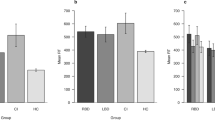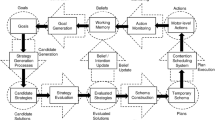Summary
The choice reaction time performances of matched groups of hospitalized patients diagnosed schizophrenic or depressed were compared with normal controls to test a hypothesis concerning thought disorder specific to schizophrenia. Both patient groups were abnormal compared to controls providing evidence inconsistent with the diagnostic specificity issue. The results are discussed in terms of cognitive dysfunction in depression, the effects of institutionalization and the problems of diagnostic heterogeneity.
Similar content being viewed by others
References
Broadbent DE (1971) Decision and stress. Academic Press, London New York
Briggs GE, Blaha J (1969) Memory retrieval and central comparison times in information processing. J Exp Psychol 79:395–402
Briggs GE, Johnson AM (1973) On the nature of central processing in choice reactions. Memory Cog 1:91–100
Briggs GE, Swanson JM (1970) Encoding, decoding and central functions in human information processing. J Exp Psychol 86:296–308
Byrne DG (1976) Choice reaction times in depressive states. Br J Soc Clin Psychol 15:149–156
Cancro R (1968) Thought disorder and schizophrenia. Dis New Syst 29:846–849
Cancro R, Sutton S, Kerr J, Sugarman AA (1971) Reaction time and prognosis in acute schizophrenia. J Nerv Ment Dis 153:351–359
Cornell DG, Suarez R, Berent S (1984) Psychomotor retardation in melancholic and nonmelancholic depression: cognitive and motor components. J Abnorm Psychol 93:150–157
Fitts PM, Deininger RL (1954) S-R compatibility: correspondence among paired elements with stimulus and response codes. J Exp Psychol 48:483–492
Friedman AS (1964) Minimal effects of severe depression on cognitive functioning. J Abnorm Psychol 69:237–243
Garmezy N (1978) Attentional processes in adult schizophrenia and in children at risk. J Psychiatr Res 14:3–34
Garner WR (1962) Uncertainty and structure as psychological concepts. Wiley & Sons, New York London
Goldberg SC (1972) Advantages and problems in the use of performance tests to study schizophrenic deficits. Psychopharmacol 24:1–5
Goldstein G (1978) Cognitive and perceptual differences between schizophrenics and organics. Schizophr Bull 4:160–186
Granick S (1963) Comparative analysis of psychotic depressives with matched normals on some untimed verbal intelligence tests. J Consult Psychol 27:439–443
Harris JE (1975) An abbreviated form of the Phillips rating scale of premorbid adjustment in schizophrenia. J Abnorm Psychol 84:129–137
Harrow M, Quinlan D (1977) Is disordered thinking unique to schizophrenia? Arch Gen Psychiatry 34:15–21
Hemsley DR (1976) Attention and information-processing in schizophrenia. University of London, unpublished Ph.D. thesis
Hemsley DR (1976a) Attention and information processing in schizophrenia. Br J Soc Clin Psychol 15:199–211
Hemsley DR (1978) Limitations of operant procedures in the modification of schizophrenic functioning: the possible relevance of studies of cognitive disturbance. Behav Anal Modif 2:165–173
Hick WE (1952) On the rate of gain of information. Q J Exp Psychol 4:11–26
Karras A (1973) Effects of competing and complex responses on the reaction time of acute psychiatric groups. J Abnorm Psychol 82:134–138
Kolakowska T, Williams AO, Jambor K, Ardern M (1985) Schizophrenia with good and poor outcome. III: Neurological “soft” signs, cognitive impairment and their clinical significance. Br J Psychiatry 146:348–357
Miller WR (1975) Psychological deficit in depression. Psychol Bull 82:238–260
Ogden GD, Alluisi EA (1980) Stimulus-response compatibility effects in choice reactions and memory scanning. J Exp Psychol 6:430–438
Oltmanns TF (1978) Selective attention in schizophrenic and manic psychoses: The effect of distraction on information processing. J Abnorm Psychol 87:212–225
Penk WE (1978) Effects of ambiguous and unambiguous stimulus word differences on popular responses of schizophrenics. J Clin Psychol 14:838–843
Phillips L (1953) Case history data and prognosis in schizophrenia. J Nerv Ment Dis 117:515–523
Rodnick EH, Shakow D (1940) Set in the schizophrenic as measured by a composite RT index. Am J Psychiatry 97:214–225
Rosenthal D, Lawlor WG, Zahn TP, Shakow D (1960) The relationship of some aspects of mental set to degree of schizophrenic disorganization. J Pers 28:26–38
Shimkunas AM (1970) Reciprocal shifts in schizophrenic thougt processes. J Abnorm Psychol 76:423–426
Slade PD (1971) Rate of information processing in a schizophrenic and a control group: The effect of increasing task complexity. Br J Soc Clin Psychol 10:152–159
Stephens JH (1970) Long-term course and prognosis in schizophrenia. Semin Psychiatry 2:464–485
Venables PH (1958) Stimulus complexity as a determinant of the reaction time of schizophrenics. Can J Psychol 12:187–190
Venables PH, O'Connor N (1959) Reaction time to auditory and visual stimulation in schizophrenic and abnormal subjects. Q J Exp Psychol 11:175–179
Wechsler D (1955) Manual for the Wechsler adult intelligence scale. Psychological Corporation, New York
Wickens CD (1974) Temporal limits of human information processing: A developmental study. Psychol Bull 81:739–755
Williams RM, Alagaratnam W, Hemsley DR (1984) Relationship between subjective self-report of cognitive dysfunction and objective information-processing performance in a group of hospitalized schizophrenic patients. Eur Arch Psychiatr Neurol Sci 234:48–53
Wing JK (1975) Impairment in schizophrenia: a rational basis for social treatment. In: Wirt RD, Winokur G, Roff M (eds) Life history research in psychopathology. University of Minnesota Press, Minneapolis
Yates AJ (1966) Data-processing levels and thought disorder in schizophrenia. Aust J Psychol 18:103–117
Zahn TP, Carpenter WT (1978) Effects of short-term outcome and clinical improvement on RT in acute schizophrenia. J Psychiatr Res 14:59–68
Author information
Authors and Affiliations
Rights and permissions
About this article
Cite this article
Williams, R.M., Hemsley, D.R. Choice reaction time performance in hospitalized schizophrenic patients and depressed patients. Eur Arch Psychiatr Neurol Sci 236, 169–173 (1986). https://doi.org/10.1007/BF00380945
Received:
Issue Date:
DOI: https://doi.org/10.1007/BF00380945




